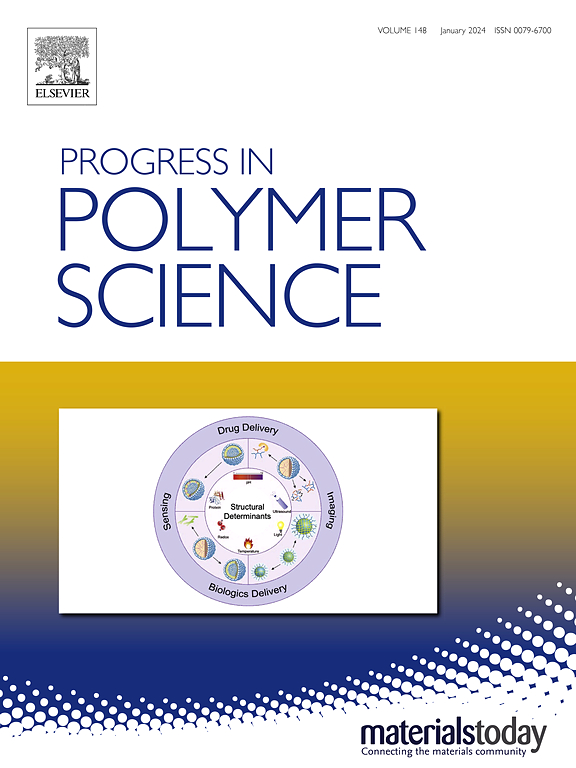PEDOT:PSS-based electronic materials: Preparation, performance tuning, processing, applications, and future prospect
IF 26.1
1区 化学
Q1 POLYMER SCIENCE
引用次数: 0
Abstract
Poly(3,4-ethylenedioxythiophene):polystyrene sulfonate (PEDOT:PSS) represents a breakthrough in addressing the processability challenges of traditionally insoluble and infusible conducting polymers (CPs). It uniquely combines solution processability with high chemical and thermal stability, excellent biocompatibility, and outstanding electrical, optical, and mechanical properties. For over 35 years, PEDOT:PSS has remained at the forefront of both commercial and academic research in organic electronics, spanning disciplines such as chemistry, materials science, biology, electronics, medicine, energy, and engineering. This review offers a comprehensive and systematic overview of PEDOT:PSS, covering synthesis strategies, performance optimization, composite system design, and processing techniques across various material forms, including aqueous dispersions, powders, films, nanofibers, hydrogels, aerogels, elastomers, and sponges. It also discusses the specific requirements, current status, and ongoing challenges in both laboratory research and industrial applications. In light of recent advances in flexible, wearable, and multifunctionally integrated electronics, this review outlines future development directions with an emphasis on miniaturization and environmental sustainability. Particular attention is given to emerging applications in flexible, wearable, biomedical, and intelligent electronics, aiming to provide researchers with critical insights to inspire innovation at the frontiers of this rapidly evolving field.


基于pss的电子材料:制备,性能调整,加工,应用和未来展望
聚(3,4-乙烯二氧噻吩):聚苯乙烯磺酸盐(PEDOT:PSS)在解决传统的不溶性和不溶性导电聚合物(CPs)的可加工性挑战方面取得了突破。它独特地结合了高化学和热稳定性,优异的生物相容性以及出色的电学,光学和机械性能的溶液加工性。35年来,PEDOT:PSS一直处于有机电子学商业和学术研究的前沿,涵盖化学,材料科学,生物学,电子学,医学,能源和工程等学科。这篇综述提供了PEDOT:PSS的全面和系统的概述,包括合成策略、性能优化、复合系统设计和各种材料形式的加工技术,包括水分散体、粉末、薄膜、纳米纤维、水凝胶、气凝胶、弹性体和海绵。它还讨论了实验室研究和工业应用中的具体要求、现状和正在进行的挑战。鉴于柔性、可穿戴和多功能集成电子产品的最新进展,本文概述了未来的发展方向,重点是小型化和环境可持续性。特别关注柔性,可穿戴,生物医学和智能电子领域的新兴应用,旨在为研究人员提供关键见解,以激发这一快速发展领域前沿的创新。
本文章由计算机程序翻译,如有差异,请以英文原文为准。
求助全文
约1分钟内获得全文
求助全文
来源期刊

Progress in Polymer Science
化学-高分子科学
CiteScore
48.70
自引率
1.10%
发文量
54
审稿时长
38 days
期刊介绍:
Progress in Polymer Science is a journal that publishes state-of-the-art overview articles in the field of polymer science and engineering. These articles are written by internationally recognized authorities in the discipline, making it a valuable resource for staying up-to-date with the latest developments in this rapidly growing field.
The journal serves as a link between original articles, innovations published in patents, and the most current knowledge of technology. It covers a wide range of topics within the traditional fields of polymer science, including chemistry, physics, and engineering involving polymers. Additionally, it explores interdisciplinary developing fields such as functional and specialty polymers, biomaterials, polymers in drug delivery, polymers in electronic applications, composites, conducting polymers, liquid crystalline materials, and the interphases between polymers and ceramics. The journal also highlights new fabrication techniques that are making significant contributions to the field.
The subject areas covered by Progress in Polymer Science include biomaterials, materials chemistry, organic chemistry, polymers and plastics, surfaces, coatings and films, and nanotechnology. The journal is indexed and abstracted in various databases, including Materials Science Citation Index, Chemical Abstracts, Engineering Index, Current Contents, FIZ Karlsruhe, Scopus, and INSPEC.
 求助内容:
求助内容: 应助结果提醒方式:
应助结果提醒方式:


